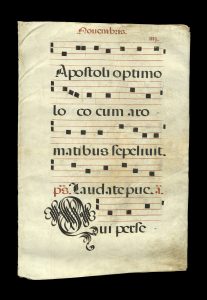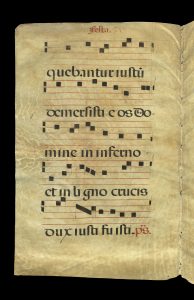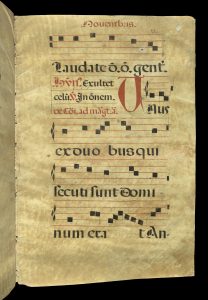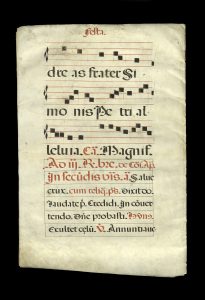Tags
11th century hymn, Acta, Andrew, apocryphal, Apostle, Christ, cross, crucifixion, Feast of St. Andrew, heaven, hell, historia, Magnificat, martyrdom, Maximilla, Office of St. Andrew, parch, Psalm 113, Psalm 117, Psalm 18, servants, Simon Peter, spices, Vespers, vocation

(Maximilla Christo amabilis
corpus) Apolstoli optimo
loco cum aro-
matibus sepelivit
Ps(alm) Laudate pue(ri) A(ntiphon)
(Maximilla, a woman dear to Christ,
too the body) of the Apostle
and, embalming it with spices,
buried it in the most honored place.
Psalm. Praise the Lord, O you servants…

Qui perse-
quebantur iustu(m)
demersisti eos Do-
mine in inferno
et in ligno crusis
dux iusti fuisti Ps(alm)
You, O Lord, plunged
into hell those who persecuted
the just man, and You were his guide
on the wood of the cross. Psalm

Laudate omnes gent(es laudate Dominum)
Hy(m)n(us) Exultet caelu(m, laudibus)
V(ersus) In omnem (terram exivit sonus eorum)
Unus
ex duobus qui
secuti sung Domi-
num erat A(n)
Sing praises, all you peoples, praise the Lord…
Hymn. Let heaven exult with praises…
Verse. Their sound went out unto all the earth…
One of the two who
followed the Lord was An-

dreas frater Si-
monis Petri. Alleluia.
Ca(nent) Magnifi(cat)
Andrew the brother
of Simon Peter. Alleluia.
Let them now sing the Magnificat
The hymns of the previous texts are sung on the Feast of St. Andrew, one of the apostles and the brother of Simon Peter. They are sung at Vespers on his feast celebrated variously but usually on November 30th. The Office of St. Andrew is not a historia presenting events in a logical and chronological order. It focuses mainly on two themes, as indicated in the passages quoted here: 1) his vocation or calling as one of the apostles; and 2) his martyrdom by crucifixion, an event related in the apocryphal Acta.
~Transcription, translation, and commentary by James T. Svendsen, associate professor emeritus, World Languages and Cultures, The University of Utah
MS chant frag. 8 — Parchment leaves from an Antiphonal, 16th c Italy/S. France. from the Proper of Saints, Feast of St. Andrew, First/Second vespers.
~Description by Elizabeth Peterson, associate professor, Dept. of Art & Art History, The University of Utah, from Paging Through Medieval Lives, a catalog for an exhibition held November 2, 1997 through January 4, 1998 at the Utah Museum of Art.

You must be logged in to post a comment.